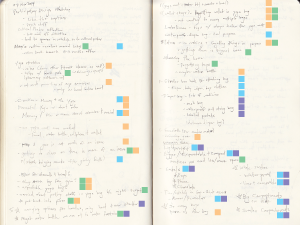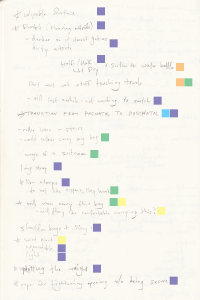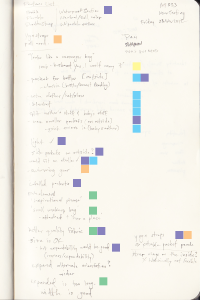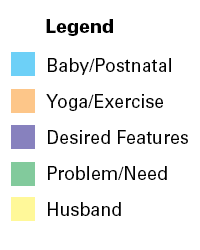The participatory design workshop was quite enlightening as it revealed deep insights into our target users especially regarding the design problem. Our initial prototype received a strong negative reaction with a strong bias of associating our wheeled design sketch with a carry-on suitcase. However, they were quite interested in alternate locking mechanisms to facilitate easier access such as magnetic clasps or quick release snaps. Through our evaluation we were able to generate a list of features that our users would like in their ideal bag. The list of the features generated during the participatory workshop is as follows:
- Durable
- Expandable
- Shoulder strap + hand / arm straps
- Pull cord for the top instead of a zipper
- Yoga straps
- Detachable waterproof section
- Wipeable surface
- Neutral/dull color
(Data regarding analysis on our notes are attached below)
These features cleared the direction for the next stage for development of our medium-fidelity prototype. The users wanted a multipurpose bag, not just a specialized yoga bag, which can stay with them in their postnatal stage. The bag should perform the functions as required for yoga, exercise and also as a baby diaper bag all-in-one. Based on this feedback, the design team developed a medium-fidelity prototype for the user group.
We ran a test evaluation session with the user group to get their feedback on the design, features, and run some tests to see how well the current design fits their needs and wants. The session was started by going over the results of the participatory workshop and giving the users a rundown of the feature list we developed from their input. After that, we showed our medium fidelity prototype to the users and pointed out the integration of the features in the bag.
One of the participant’s husband was present during the evaluation session and as the husband’s role as a potential factor in purchasing a bag their opinion was valuable. He commented that the bag “looks like a messenger bag” and remarked that the neutral grey color of our prototype was fine. The husband said that he would have no problems carrying the bag.
One of the first things that arose from our test evaluation was for a feature request for an external pocket on the side of the bag for bottles. This is to store a water bottle, or for holding a baby’s feeding bottle. Having it on the outside of the bag would afford quick, and easy access. The participants were keen on letting us know this as soon as we started as they realized they forgot to inform us of this feature after the participatory workshop.
We conducted a few usability tests by asking a participant to pack up the bag with items from the bag they regularly use. She packed the baby items in one of the bigger pockets and the mother’s items in the other big pocket. She mentioned that this was an easy way to organize and find things. She mentioned that it would be nice to have some additional smaller pockets on the outside for quicker access to items such as a baby soother. With the bag full, she was asked to carry the bag and test the weight of the bag overall. She mentioned that the bag was light and easy to carry and that the long shoulder strap would fit perfectly on the stroller. She was then asked to retrieve an item from the bag, baby wipes, while carrying it. She was able to get the baby wipes out with one hand easily and quickly.
The other user in the evaluation mentioned that it would be nice to have labelled side pockets to serve as a reminder and memory functionality when packing and searching the bag. This was a feature that was mentioned during the participatory workshop and was an oversight by the design team.
An interesting insight was the suggestion from the users was a missing element of fun in the design. They suggested perhaps in the form of an inspirational phrase. An alternative form proposed was the idea of a small, makeup bag attached loosely on a string tied inside the bag.
Regarding the durability of the bag, the users mentioned that it would be better to have a higher quality fabric for the bag. They were quite comfortable with the bag size and quite happy with the stretchability of the fabric. The expandable functionality was not successful at all. When the bag was configured in the expanded mode, the users felt that it looked like a sack rather than a bag. They were fine with the non-expanded version of the bag but wanted stretchability in the fabric. From this result, we decided to remove the expandability feature in the next version of our prototype.
The users liked the straps on the outside for holding the yoga mat and mentioned that these straps could also be used to hold a baby blanket. However, this would be only possible if there was a cover on top that can protect the blanket from rain. We agreed that a cover for the strap area would be a beneficial feature.
One of the participants mentioned that she liked the fact that the shoulder strap can be removed if they are not using it. She suggested the case that the straps’ rings should be attached inside so that they are not visible, however this idea was discarded when we mentioned that the top of the bag has a pull cord and once tightened would make carrying the shoulder difficult due to the narrow opening.
At the end of the testing evaluation, the users were asked to rank different features of the bag on a scale from 1 to 5 . The results are as follows:
Two participants A and B
Durability: Weak [1] to Strong [5]
A: 2
B: 2
Weight: Light [1] to Heavy [5]
A: 1
B: 1
Number of compartments: Not Enough [1] to Enough [5]
A: 3
B: 4
Easy to use: Not Easy [1] to Easy [5]
A: 4
B: 4
Overall (How much they liked the bag): Don’t Like [1] to Like A Lot [5]
A: 3
B: 3
Below are analysis’ of our notes from both our participatory design workshop and our testing evaluation.



